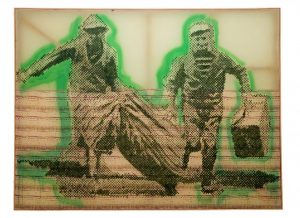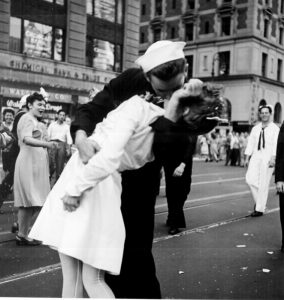The gravel on the driveway outside the studio crunches underfoot. Beneath a porch in front of the car park, I notice a drum kit that doesn’t seem to have been played in a long time, half-hidden by a greying sheet. I close the gate by nudging it with my shoulder as I turn the key and join Gabriel in his car with the engine running.
Discussing Gabriel’s work with him means letting yourself be invited into the unfinished, immersing yourself in the process he places himself in. Through the micro-narratives in his work, Stöckli succeeds in making giddy leaps between the intimate and the collective, while his imagination slowly resonates with ours, as happens with shared memories, as if in the complicity of a friendship.
In the car, we talk at length about what we observed together in his studio, and as we drive, an image is seared onto my retina: a field stretching beyond a guardrail, a car parked along a road with the driver’s door and trunk open, and a little further on, someone doing something I don’t have time to understand. On the stereo, we put That’s Entertainment by The Jam, which goes:
Waking up at six AM on a cool warm morning
Opening the windows and breathing in petrol
An amateur band rehearsing in a nearby yard
Watching the telly and thinking about your holidays
That’s entertainment, that’s entertainment
This ’77 track recites a series of short evocative phrases offering a glimpse of British working-class life, alternating with an ironic “that’s entertainment.” Gabriel Stöckli’s works likewise tell flashes of stories that draw mainly from his everyday life. Stöckli manipulates simple materials such as paper, wood, artefacts, mirrors, cement and stationery, and in the immediacy of certain technical solutions—a paperclip as a “catch” for a drawer, sandpaper as a passepartout—we come across his ability to unhinge the primary use of an object, identifying alternative uses for it.
The two MDF boards engraved with a freehand cutter, Curva di notte and Alla guida dei pensieri, are inspired by the iconic cartoons from La Settimana Enigmistica. In his personal archive, the artist collects many cut-outs and scans of these humorous images, which he then recomposes or reinterprets by appropriating their peculiar drawing style. The two juxtaposed works act as an unlikely visual riddle, alluding to a multitude of potential plots.
Gabriel Stöckli allows drawings, sketches and passport-size photos to decant in a series of classifiers that over time spontaneously begin to generate subtle juxtapositions and narrative points of contact between them. Thus, by extrapolating various materials from the archive, they may be identified as potential works by the artist in an intuitive manner and then processed through simple gestures such as cutting or folding. A key example of this methodology is the series of framed works in the first room, all of which are assembled with sandpaper passepartouts, as in Luna, lune, which become part of the composition.
The series continues with a sketch repeated twice, Bozzetto confuso, then with Domenica, Chiasso: a slightly blurred photograph and onomatopoeic phrases obtained from sheets of transferable typefaces. Similarly, the honeycombed wooden desk that for years accompanied the artist in his atelier and that he saw change and bear the traces of many works, now finds itself cut up and broken down, returned to its state of almost raw material, set up as a site-specific element on the staircase leading to the gallery mezzanine.
Two lovers kissing amongst the scream of midnight
Two lovers missing the tranquillity of solitude
Getting a cab and travelling on buses
Reading the graffiti about slashed seat affairs
I tell ya that’s entertainment, that’s entertainment
Turning the corner and entering the second room of the gallery, we are drawn in by the warm light pouring out of a series of drawers on the wall. Inside them, drawings, sketches and photographs are broken up and juxtaposed in the reflections of a series of mirrors. We have the impression of looking at an architectural model and wandering through the many changing mockup scenes.
These previously unseen works sum up the artist’s intention to create subtle aesthetic-narrative environments and atmospheres also through enlargements and miniatures. This is the case with Scaletta, which shows an urban element photographed in Genoa—one not particularly characteristic but for this very reason meaningful in terms of the stories that have certainly unfolded there.
Just as in the song that gives this exhibition its title, there is a certain poetic realism in the stories told by Gabriel. At times, we have the impression that his references might fall foul of nostalgia, a sense of disconcertment, as a confused feeling of lonely dislocation begins to emerge from them, exasperated by the flow of over-representation of the collective everyday dimension to which we are exposed.
It is then that certain works reach out to us as heartening as a message from a friend: a low-resolution shot, framed subjectively, of an ice cream eaten in the driver’s seat.
—Giacomo Galletti
at Studio Dabbeni, Lugano
until August 24, 2024




